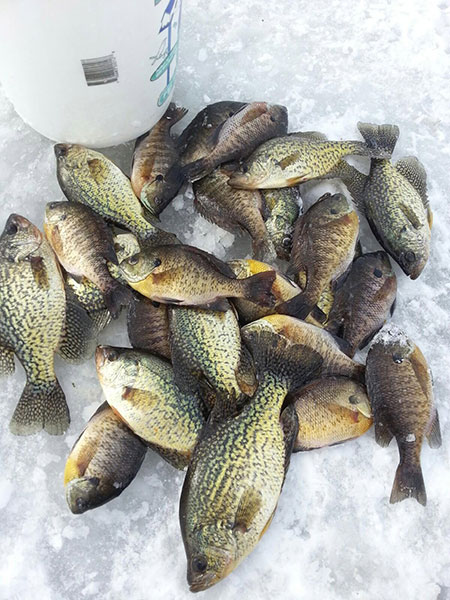By Louie Stout
 Ice fishing for panfish
Ice fishing for panfish
Now that the polar vortex has left us – hopefully for good – it’s time to get energized about ice fishing again.
But hey, it’s late in the season. Anyone who ice fishes knows the bite isn’t nearly as good as it was with first ice.
At least not until we start getting a real thaw and are into that precarious part of the season known as “last ice.”
What do you do until then? We sought the advice of Brian Hensley at Clear H2o Tackle, one of the most avid ice fishermen we know.
But first, let’s talk about the ice conditions. The thaw is mushin’ up the snow and the ice may be honeycombing in some areas. But several lakes still have a good 8 to 10 inches, except on those waters where the birds kept areas open prior to the recent deep freeze. The shoreline areas may be thawing quickly, so be careful. You still need to use common sense before trekking across unknown waters.
Hensley believes the ice should hold up for at least the next week or so, especially with colder nights helping to tighten it up.
The deep bite
Most of the good schools of fish are still hanging deep but they haven’t been overly aggressive. Hensley says that could be because they’ve basically been inactive and haven’t needed to feed, or fishing pressure has made them more wary.
“This is the time of year fish are in a funk and so I downsize my lures even more,” he said. “I’ll go to lighter tungsten jigs or flies and even add small livebait like a spike.”
He will fish with 2-pound fluorocarbon line to help get the lighter bait to depths easier and it “has a better feel and gives me a better hookset in deeper water.”
Some anglers avoid areas that are getting a lot of pressure, but those other fishermen are there for a reason; the fish are probably there, too. But if you sense the pressure has shut off the action, simply move 50 or 100 yards away and use your fishfinder to locate another school that might be more active.
The Shallow Migration
Hensley says he’s noticed that sometime during early March the fish start leaving the deep haunts and move shallower.
“Once we have four or five nights with temperatures above freezing, look for the crappies, perch and pike, and possibly the bluegills, to start moving shallower,” he said. “The perch, pike and crappies spawn shortly after ice out, and their biological clocks know it’s time to start moving toward those spawning areas even though there is still ice on the lake.”
The perch and pike are looking for vegetation; perch will spawn on any short-cropped weeds (like sand grass) while the pike prefer weedy bays. Crappies are nest builders. Perch spawn first, followed by pike and crappies.
Hensley said the bluegills he’s catching now have firm, small eggs while the crappie eggs are bigger and softer and pike eggs are even softer.
So that biological clock is ticking.
Once the thaw is in full swing, the fish will start feeding more heavily to prepare for the demanding spawning ritual.
“I tend to see them moving shallower soonest on lakes that have inlets where the run-off water from melting snow comes in from creeks, ditches or even other lakes that are connected,” he said. “Fishing will get good again in the same channels that were good earlier in the season.”
However, use caution on those lakes with an inflow and don’t get too close to inlets with moving water. The ice will be eroding there!


